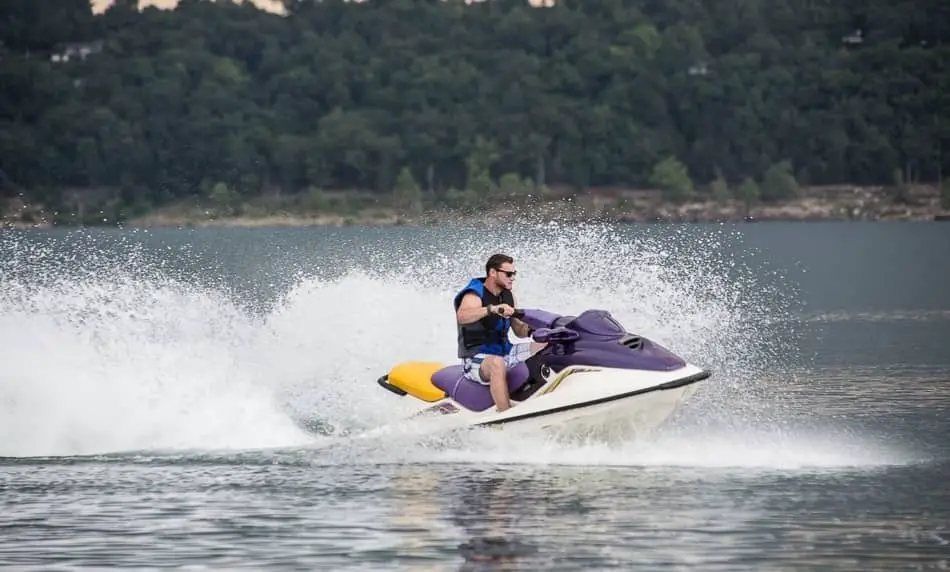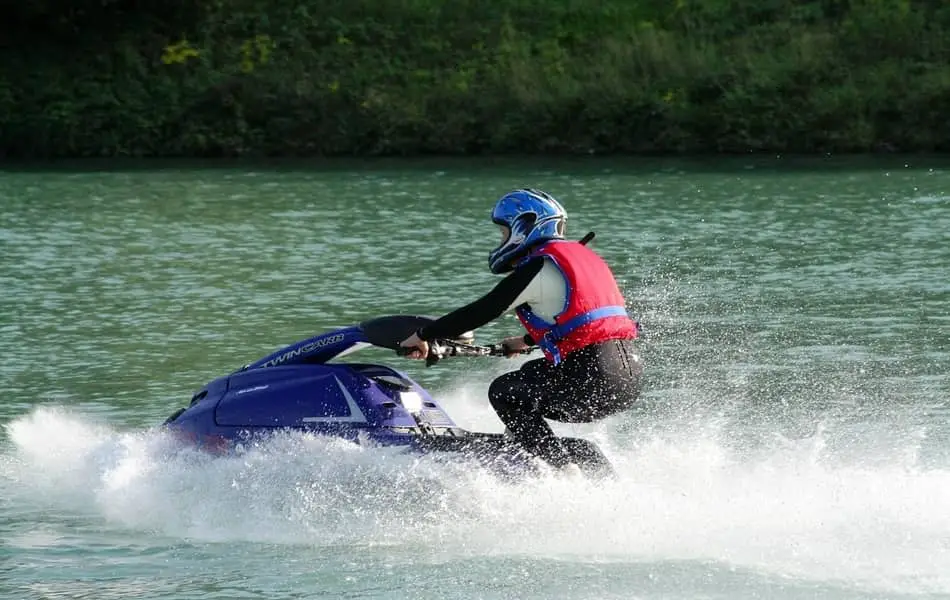Jet skiing is a fun and excellent activity for you and your family. As a buyer or rider, at one point in time, you might be concerned about getting into jet skiing due to some risks or dangers, so I did some research to find out, statistically, if jet ski (PWC) is safe or not.
Jet ski (PWC) can be a dangerous activity. However, some statistics show that you can dramatically reduce the risk of injury and dangers by doing a few changes to the way you ride the jet ski. You can completely turn it into a very safe and fun activity to do with your kids and family.
Any sport or activity has its risks and dangers, but those risks or threats shouldn’t concern you from doing those activities. By doing it the right way and the correct way will give you a lot of fun and thrill (by making you no need to worry about the risk of injuries or dangers due to that activity).
So, doing a few changes to the way you ride will dramatically decrease the risk of injuries or dangers. The real question you should be asking yourself is not jet ski safe or not. Of course, it is. The real question you should ask yourself is how to prevent that.
Jet skiing is an enjoyable activity, and it is a safe activity if you do it the right way. That being said, let’s see the statistics of the injuries and accidents due to jet skiing and then some safety precautions you need to take.
Before going into the actual statistics, you need to know some of the terminologies. And these are just marketing names for each manufacturer.
- Jet Ski = Kawasaki
- Waverunner = Yamaha
- Sea-Doo = Sea-Doo
Small note: When I say jet ski (which is a trademark of Kawasaki), I am also referring to all PWCs types (Jet Ski, WaveRunner, and Sea-Doo) and will use the two names interchangeably.

Interesting Statistics on Jet ski accidents
The statistics below can be an excellent resource for understanding the major causes of jet ski accidents. And by knowing the causes, you can avoid them by making slight changes in the way you ride, which can cut your risk of serious injury immensely.
Related post – Check my article on Is boating safe or dangerous? (opens in a new tab) to get an idea about how safe is boating compared to jet skiing.
- Among all the boating accidents, around 20 -25% of them are related to personal watercraft, such as jet skis, sea-doo, Waverunner, etc. (source). With that, you can tell PWCs are safer than boats.
- From 2010 to 2019, a total of 43,058 boating accidents occurred (source). Out of which, 10,757 are related to PWCs, and 16,895 are related to motorboats (open and cabin motorboats). With that, you can tell PWCs are safer than boats.
- More than 60% of the accidents related to jet skiing are caused due to a collision with a recreational vessel (source), which can be prevented by the proper lookout and not driving carelessly.
- Among all the deaths related to boating, around 10% of them are related to personal watercraft, such as jet skis, sea-doo, Waverunner, etc. (source). With that, you can tell jet skis are safer than boates.
- Operator inattention and less experience are the second most causes of jet ski accidents, which is around 45 – 50% (source). That can be prevented by keeping all the things that distract while operating.
- However, there is a steady decrease in personal watercraft accidents from 2010 – 2019. That ensures that many people are becoming knowledgeable about jet skiing.
- More than 40% of accidents occurred due to excessive speed and collisions (source), which can be prevented easily by not driving the jet ski fastly in unnecessary areas (where there are many other boaters).
- More than 50% of the deaths related to jet skiing are related to drowning (source), despite the fact that life jacket is most common among the jet skiers.
- However, there is a steady decrease in personal watercraft injuries from 2010 – 2019. That ensures that many people are becoming knowledgeable about jet skiing.
Inflatable boats, Kayak &Canoe, motorboats, and PWC accidents are given below in the table. By looking into the statistics, you will get to know the distinctions between PWC accidents and other boat accidents.
| Year | Inflatable boat | Kayak and canoe | Open and closed motorboats | PWC |
| 2010 (source) | 46 | 212 | 1942 | 1221 |
| 2011 (source) | 51 | 236 | 1887 | 1158 |
| 2012 (source) | 47 | 200 | 1825 | 1111 |
| 2013 (source) | 32 | 221 | 1603 | 954 |
| 2014 (source) | 32 | 242 | 1645 | 891 |
| 2015 (source) | 40 | 221 | 1642 | 1023 |
| 2016 (source) | 30 | 275 | 1800 | 1072 |
| 2017 (source) | 27 | 256 | 1587 | 1028 |
| 2018 (source) | 38 | 249 | 1470 | 1055 |
| 2019 (source) | 25 | 245 | 1494 | 1062 |
You can see the accidents, injuries, and deaths related to the jet skis (PWCs) in the table below. By looking into the statistics, you will get to know how many accidents, injuries, and deaths occur in the past years and their trends.
| Year | Deaths | Injuries | Accidents |
| 2010 | 38 | 776 | 1221 |
| 2011 | 44 | 764 | 1158 |
| 2012 | 58 | 721 | 1111 |
| 2013 | 36 | 601 | 954 |
| 2014 | 34 | 592 | 891 |
| 2015 | 33 | 623 | 1023 |
| 2016 | 46 | 675 | 1072 |
| 2017 | 46 | 624 | 1028 |
| 2018 | 42 | 634 | 1055 |
| 2019 | 46 | 614 | 1062 |
Related post – To know Boats vs. PWC, which ones are safer, check my article to know statistically which ones are safer.
Some of the safety tips to be followed while jet skiing

Now, you got to know some of the significant causes of jet ski accidents, such as less experience, alcohol usage, carelessness, etc. Then, you can avoid them by making some changes to the way you ride.
You can check one of my articles to know the Major causes of boating accidents (opens in a new tab) in a detailed way for each case (cause). Okay, let’s see some of the safety tips to take while jet skiing.
1. Don’t drive the jet ski too fastly
- More than 25% of the accidents related to jet skiing are caused due to riding the jet ski too fastly. By doing those slight changes to the way you ride the jet ski (now not driving the jet ski too fastly), you can prevent most of the accidents.
- By avoiding driving fastly while operating the jet ski, you are 25% less likely to die in a jet ski accident.
2. Don’t drink alcohol while operating the jet ski
- Alcohol consumption is causing the majority of deaths related to jet ski. The accidents are significantly less, but after falling into the water, it’s hard to get back onto the jet ski because getting back onto the jet ski after drinking alcohol is difficult, and people are drowning.
- By avoiding drinking alcohol while operating the jet ski, you are 10% less likely to die in a jet ski accident.
3. Don’t drive the jet ski carelessly
- Carelessness while driving a jet ski is causing most accidents like collisions with recreational boats. More than 50% of the accidents occurred in jet skiing are collisions with recreation boats, which tells that the riders are not careful while riding the jet ski.
- Riding the jet ski slowly in the fewer traffic areas will reduce the majority of the accidents. By avoiding carelessness while operating the jet ski, you are 20% less likely to die in a boating accident.
4. Take a boating safety course
- Before starting boating or jet skiing for the first time or as a beginner, the essential thing you need to do is take a boating safety course. By taking a course, you will get to know about the jet ski, boat, terminology, rules, laws, etc., which help you a lot in advance.
- By taking a boating safety course, you will get some experience, and you will get to know the rules, which makes you 25% less likely to die or injure in a jet ski accident.
Bottom line
Safety will be the first priority to anyone, and by taking some measures while jet skiing (operating the jet ski), you can do that. After doing those changes to the way you ride the jet ski, you can prevent the majority of the jet ski accidents.
Jet skiing is a fun activity, and it is a safe activity until if you do something wrong or neglect the rules. Jet skiing is a lot safer than motor vehicles and boats.
Many of the causes of jet ski accidents are simple causes, and you can easily prevent them. Check my article on Boating safety tips (opens in a new tab) to know the essential safety tips in detail.
